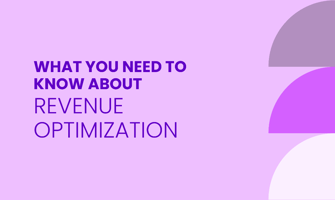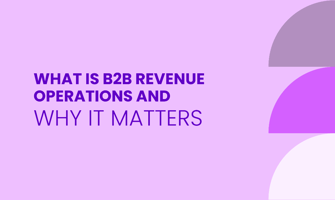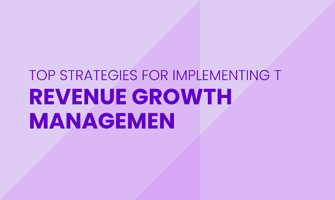Revenue optimization is the process of maximizing a company’s income by aligning pricing, sales,...
Revenue Growth Strategies: How to Increase Business Revenue
Increasing revenue is a top priority for businesses aiming to grow and succeed. Revenue growth strategies involve identifying opportunities to attract new customers, retain existing ones, and maximize the value of every transaction.
These strategies help businesses expand their market presence, improve profitability, and maintain financial stability. In this article, we’ll explore practical and effective ways to boost business revenue and ensure sustainable growth over time.
Understand the power of "revenue intelligence" by reading: "What is Revenue Intelligence? How It Works and Why It Matters."
What is Revenue Growth?
Revenue growth is one of the most important ways to measure how well a business is doing over time. It shows how much a company’s income from sales increases within a specific period, such as a month, a quarter, or a year.
By focusing on revenue growth, you can understand how effectively your business is attracting customers and generating sales. To understand revenue growth better, it’s important to know the difference between revenue and profit.
Revenue is the total amount of money your business earns from selling products or services. On the other hand, profit is what’s left after subtracting all the costs of running your business, like materials, employee wages, and rent.
While profit shows your overall financial success, revenue focuses purely on how much money is coming in from sales. Both are essential, but revenue growth specifically highlights sales performance.
Here’s a simple example to illustrate revenue growth: Imagine your business made $50,000 in sales last year. This year, your sales grew to $60,000. This $10,000 increase means you experienced revenue growth of 20%.
![]()
Importance of Growing Revenue
Revenue growth is key for the health and future of your business. It fuels your ability to operate, adapt, and thrive in a competitive market. Without steady growth, businesses can struggle to keep up with challenges or seize new opportunities.
First, growing revenue ensures business sustainability. It helps cover essential operational expenses like salaries, utilities, and raw materials. With consistent revenue, you can weather economic downturns, respond to shifts in market demands, and invest in necessary changes to stay relevant.
Second, revenue growth strengthens your market competitiveness. More revenue means you can invest in innovation and development, which helps you create better products or services. It also allows you to expand into new markets or improve your customer experience.
Finally, increased revenue creates opportunities for reinvestment. Some key areas where businesses can reinvest include:
Launching new projects to attract more customers or tap into different markets.
Improving infrastructure, such as upgrading technology or refining processes, to boost efficiency.
Scaling operations, like hiring more staff or expanding production, to meet growing demand.
Strategies to Increase Business Revenue
1. Align Revenue Goals Across Teams
To grow your business revenue, it's important to ensure that your teams work together toward shared goals. When everyone is aligned, your efforts become more focused, and it’s easier to achieve consistent results.
One of the most impactful ways to do this is by fostering collaboration between your sales and marketing teams. Sales and marketing often operate as separate units, but when these teams align, they can create unified strategies that directly drive revenue growth.
For example, marketing can generate leads that are more relevant to the sales team, making it easier for them to close deals. Sales, in turn, can share feedback on customer needs and behaviors, helping marketing fine-tune campaigns to attract the right audience.
To make this alignment effective, your business needs shared revenue targets and key performance indicators (KPIs). These targets act as a common reference point, ensuring that all departments are working toward the same objectives.
Here are a few ways to align your teams:
Define clear revenue goals: Set specific targets like monthly sales figures or customer acquisition numbers that both sales and marketing aim to achieve.
Establish shared KPIs: Use metrics like lead conversion rates, average deal size, or revenue per customer to track progress objectively.
Encourage regular communication: Schedule joint meetings for sales and marketing to discuss performance, share insights, and adjust strategies.
Utilize collaborative tools: Platforms like CRM software or shared dashboards can help both teams access the same data and track progress in real time.
2. Analyze Revenue Trends to Predict Opportunities
To grow your business revenue, you need to understand where it’s coming from and where it could go. One of the best ways to do this is by analyzing your historical revenue data.
By reviewing past performance, you can spot patterns and trends that reveal what works, what doesn’t, and where opportunities might be hiding.
Tools like 180ops simplify this process by consolidating data from multiple sources and providing actionable insights. With 180ops, businesses can forecast revenue opportunities, identify growth trends, and make data-driven decisions to maximize profitability.
Start by gathering your revenue data from previous months or years. Look for trends like seasonal spikes, periods of slower sales, or consistent revenue growth in specific product lines or services.
For example, if you notice that sales peak every holiday season, you might decide to invest more in marketing during that time. On the other hand, if revenue drops consistently in the summer, you could look into ways to fill the gap, such as offering promotions or launching new products.
To make this process easier and more accurate, use tools and techniques that specialize in data analysis. Predictive analytics software is particularly helpful.
It uses your historical data and combines it with current market trends to forecast future revenue opportunities. These tools can help you answer critical questions like:
Which customer segments are most likely to grow in value?
What products or services might see increased demand?
How might changes in pricing impact overall revenue?
For example, if the data suggests that a specific product is gaining popularity with a certain demographic, you can adjust your marketing strategy to target that audience more effectively. Or, if you see that one service consistently underperforms, it might be time to rethink or replace it.
This approach isn’t just about spotting opportunities it’s also about avoiding risks. Revenue analysis can reveal warning signs, such as declining sales in a once-popular product or inefficiencies in your pricing strategy. By catching these issues early, you can take action before they hurt your bottom line.
In short, analyzing revenue trends gives you a clearer picture of where you’ve been and where you could go. When you combine this knowledge with the right tools, you can make smarter decisions that drive sustainable revenue growth.
3. Identify Revenue Leaks and Fix Inefficiencies
Preventing revenue loss and improving profitability are important for sustainable business growth. To achieve this, you need to identify where your revenue is leaking and address inefficiencies that drain your resources.
One significant source of revenue leakage is unnecessary expenses. These are costs that don’t add value to your business or its goals. To optimize costs:
Review your operational expenses regularly. Are you paying for tools or software that your team barely uses? Cancel or replace them with more cost-effective options.
Evaluate your supply chain. Can you renegotiate contracts with suppliers or find more competitive pricing? Even small reductions in procurement costs can lead to noticeable savings.
Track recurring subscriptions and services. Hidden or forgotten charges can add up over time.
Another area to focus on is improving customer retention. Losing customers can be one of the biggest drains on your revenue. Retaining customers is often less expensive than acquiring new ones, and loyal customers tend to spend more over time. To boost retention:
Provide excellent customer service. Respond to inquiries quickly and resolve issues effectively.
Use feedback to identify and fix problems in your product or service. Dissatisfied customers are more likely to leave, but addressing their concerns can rebuild trust.
Create loyalty programs or incentives for repeat purchases. These can encourage customers to stay engaged with your brand.
![]()
4. Segment High-Value Customers for Personalization
Focusing on your most valuable customers is one of the smartest ways to grow your business revenue. These customers bring in the highest returns, so allocating your resources toward them can have a significant impact.
By segmenting customers based on their value, you can identify who contributes the most to your revenue. This lets you prioritize your time, budget, and efforts on the audience that drives the biggest financial results.
Instead of spreading yourself thin by marketing to everyone equally, you focus where it matters most. Here’s how businesses can tailor their strategies to serve high-value customers effectively:
Personalize marketing campaigns: Design messages that directly address the needs, preferences, and pain points of your top-tier customers.
For example, you can send them product recommendations based on their past purchases or offer exclusive deals they will find relevant. Personalization increases engagement and makes these customers more likely to make repeat purchases.
Customize product offerings: Create products or services that align with what high-value customers truly want. By understanding their specific demands, you can refine your offerings to better suit them, which can lead to larger sales or even premium pricing options.
Enhance loyalty programs: Reward your most profitable customers with perks that matter to them. This could mean early access to new products, VIP events, or meaningful discounts. Loyalty programs like this not only retain high-value customers but also encourage them to spend more over time.
When you meet the unique needs of your top customers, they feel appreciated and are more likely to stay loyal. Their loyalty translates to higher revenue and often generates positive word-of-mouth, which can attract similar high-value customers.
5. Implement Account-Based Revenue Strategies
Account-based revenue strategies focus on targeting specific, high-value accounts that can significantly contribute to your business growth.
These strategies are highly effective because they prioritize quality over quantity, directing your efforts toward the accounts that matter most. By concentrating on these key accounts, you can tailor your approach, build stronger relationships, and maximize revenue potential.
The first step is to identify key accounts. These are the customers or businesses that offer the highest revenue potential or hold strategic importance for your growth.
To find them, analyze your customer data. Look for accounts with consistent purchasing patterns, high transaction values, or strong alignment with your offerings. Strategic factors, such as their ability to influence other businesses or industries, also play a role.
Once you know which accounts to target, you need to create a personalized approach. Strong, long-term relationships are important to account-based strategies. Focus on understanding the unique needs and pain points of each key account.
Tools like account-based marketing (ABM) platforms can help you streamline this process. ABM tools allow you to send tailored messages, track engagement, and measure the effectiveness of your campaigns.
To strengthen relationships further, ensure that communication is consistent and collaborative. Work closely with your key accounts to find solutions that benefit both sides.
This can include offering customized products or services, providing dedicated account managers, or co-creating value through partnerships. The goal is to make each account feel valued and invested in the relationship.
A successful account-based strategy requires alignment across your organization. Sales, marketing, and customer success teams should work together to deliver a seamless experience for your key accounts.
Regularly share insights and progress updates within your team to ensure everyone is moving toward the same revenue goals.
By focusing on high-value accounts, building strong relationships, and utilizing the right tools, account-based strategies can drive targeted revenue growth effectively.
6. Enhance Forecast Accuracy with AI Insights
Artificial intelligence (AI) is changing the way businesses plan their revenue. By using AI-powered forecasting tools, you can make better decisions based on actual data instead of relying on guesswork.
Platforms like 180ops use advanced analytics to analyze historical data and provide real-time insights, helping businesses refine their strategies and stay competitive.
With its user-friendly interface, 180ops ensures that businesses of all sizes can leverage AI insights to improve forecast accuracy, spot opportunities, and adjust plans proactively to drive revenue growth.
For example, they can identify trends in customer behavior, seasonal sales patterns, or shifts in market demand. With this information, you can predict future revenue more reliably and adjust your strategies to meet your goals.
Another major benefit of AI is the real-time insights it provides. Traditional forecasting methods often rely on outdated or incomplete data, which makes it harder to respond to changes in the market. AI solves this problem by continuously updating its analysis as new data comes in.
This ability to adapt quickly can help you:
Spot new opportunities, such as emerging customer needs or untapped markets.
Detect risks early, like declining product demand or increased competition.
Adjust pricing strategies to remain competitive and protect profit margins.
For example, if sales for a product suddenly drop, an AI system could alert you right away and suggest possible causes based on similar past events. You can then act immediately to fix the issue, like running a targeted promotion or improving the product.
AI tools also help improve communication across your teams. By sharing clear, data-based forecasts, everyone from sales to marketing to operations can work toward the same revenue goals. This alignment improves efficiency and ensures that resources are allocated where they’re most needed.
Adopting AI for revenue forecasting doesn’t have to be complicated. Many platforms are user-friendly, making it easy to integrate them into your existing workflows. Over time, these tools can help you refine your strategies, stay competitive, and grow your business with confidence.
Conclusion
Implementing revenue growth strategies is essential for businesses to thrive in a competitive environment.
By focusing on customer acquisition, retention, and transaction optimization, companies can unlock their full potential and achieve consistent revenue increases.
Whether it's through improving customer experience, leveraging technology, or expanding product offerings, the key is to remain adaptable and data-driven. Start applying these strategies today to build a stronger, more profitable business for the future.
FAQ
What are revenue growth strategies?
Revenue growth strategies are methods businesses use to increase their income. These include attracting new customers, retaining existing ones, and finding ways to boost sales, such as upselling or expanding product offerings.
Why are revenue growth strategies important?
Revenue growth strategies help businesses improve profitability, support expansion, and maintain financial stability. They are critical for staying competitive and meeting long-term business goals.
How can businesses attract new customers to grow revenue?
Businesses can attract new customers through targeted marketing campaigns, special promotions, referral programs, and improving their online presence to reach wider audiences.
What role does customer retention play in revenue growth?
Customer retention ensures that existing customers continue to buy, which is often more cost-effective than acquiring new ones. Retained customers also tend to spend more over time and refer others to the business.
How can technology help in increasing business revenue?
Technology like CRM software, analytics tools, and e-commerce platforms can streamline operations, provide insights into customer behavior, and enable personalized marketing efforts, all of which contribute to higher revenue.




